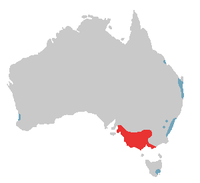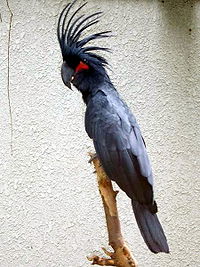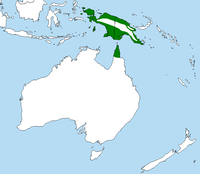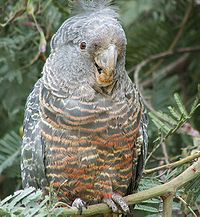Difference between revisions of "AY Honors/Parrots and Cockatoos/Answer Key"
| Line 19: | Line 19: | ||
[[Image:Bird range gang-gang cockatoo.png|thumb|200px|right|Range of the Gang-gang Cockatoo (in red)]] | [[Image:Bird range gang-gang cockatoo.png|thumb|200px|right|Range of the Gang-gang Cockatoo (in red)]] | ||
The Gang-gang Cockatoo, Callocephalon fimbriatum, is found in the cooler and wetter forests and woodlands of Australia, particularly alpine bushland. Mostly mild grey in colour with some lighter scalloping (more pronounced and buffish in females) the male has a red head and crest, while the female has a small fluffy grey crest. It ranges throughout south-eastern Australia and Tasmania. The Gang-gang Cockatoo is the faunal emblem of the Australian Capital Territory. It is easily identified by its distinctive call, which is described as resembling a creaky gate, or the sound of a cork being pulled from a bottle. | The Gang-gang Cockatoo, Callocephalon fimbriatum, is found in the cooler and wetter forests and woodlands of Australia, particularly alpine bushland. Mostly mild grey in colour with some lighter scalloping (more pronounced and buffish in females) the male has a red head and crest, while the female has a small fluffy grey crest. It ranges throughout south-eastern Australia and Tasmania. The Gang-gang Cockatoo is the faunal emblem of the Australian Capital Territory. It is easily identified by its distinctive call, which is described as resembling a creaky gate, or the sound of a cork being pulled from a bottle. | ||
| − | + | ||
| + | Gang-gang cockatoos eat fruits, and seem to have a particular weakness for Hawthorn berries (though Hawthorns are an introduced species, and not part of the cockatoo's natural diet). | ||
==4. Which three species of cockatoo are known as the most rare? == | ==4. Which three species of cockatoo are known as the most rare? == | ||
Revision as of 04:21, 7 June 2008
1. Name 15 species of parrot and five species of cockatoo that are common to Australia and be able to identify them from real life or pictures.
2. Name two species of parrot that builds its nest in a termite mound and tell where each is found.
3. Where in Australia would you find each of the following and describe the natural diet of each.
a. Long Billed Corella
The Long-billed Corella, Cacatua tenuirostris, is a cockatoo native to Australia. Species are mostly white, with a pink face and forehead. They also have faintly pink feathers on the breast and belly, and yellow on the underside of the wings and tail. The birds have a long white beak, which is used to dig for roots and seeds.
b. Great Palm Cockatoo
The Palm Cockatoo (Probosciger aterrimus) is distributed in rainforests and woodlands of New Guinea and northern Queensland, Australia. It measures around 55-60 cm in length and weighs between 500-1,000 g. It is a distinctive bird with a large crest and has one of the largest bills of any parrots (only the Hyacinth Macaw's is larger). The bill is unusual as the lower and upper mandibles do not meet for much of its length, allowing the tongue to hold a nut against the top mandible while the lower mandible works to open it.
c. Gang Gang Cockatoo
The Gang-gang Cockatoo, Callocephalon fimbriatum, is found in the cooler and wetter forests and woodlands of Australia, particularly alpine bushland. Mostly mild grey in colour with some lighter scalloping (more pronounced and buffish in females) the male has a red head and crest, while the female has a small fluffy grey crest. It ranges throughout south-eastern Australia and Tasmania. The Gang-gang Cockatoo is the faunal emblem of the Australian Capital Territory. It is easily identified by its distinctive call, which is described as resembling a creaky gate, or the sound of a cork being pulled from a bottle.
Gang-gang cockatoos eat fruits, and seem to have a particular weakness for Hawthorn berries (though Hawthorns are an introduced species, and not part of the cockatoo's natural diet).






